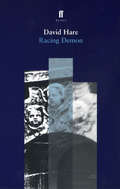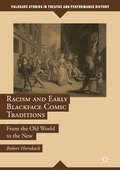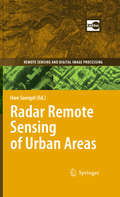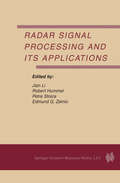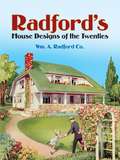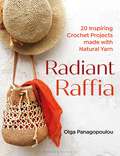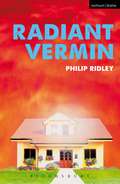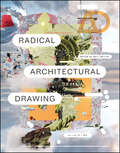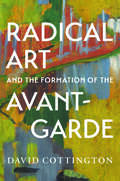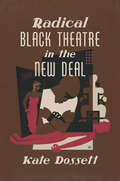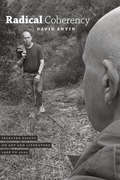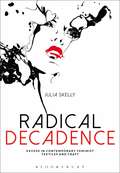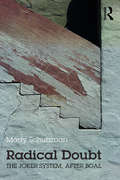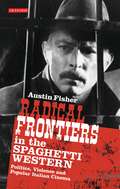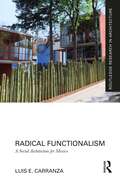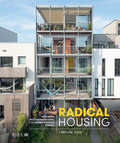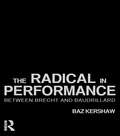- Table View
- List View
Racing Demon
by David HareHow do you fight without hate?Racing Demon reveals the struggle of four clergymen to make sense of their mission. David Hare's play opened at the National Theatre, London, in 1990 to universal acclaim, and won four awards as Play of the Year. Racing Demon was the first part of David Hare's trilogy of plays about British institutions; Murmuring Judges and The Absence of War completed the trilogy.
Racism and Early Blackface Comic Traditions: From the Old World to the New (Palgrave Studies in Theatre and Performance History)
by Robert HornbackThis book traces blackface types from ancient masks of grinning Africans and phallus-bearing Roman fools through to comedic medieval devils, the pan-European black-masked Titivillus and Harlequin, and racial impersonation via stereotypical 'black speech' explored in the Renaissance by Lope de Vega and Shakespeare. Jim Crow and antebellum minstrelsy recycled Old World blackface stereotypes of irrationality, ignorance, pride, and immorality. Drawing upon biblical interpretations and philosophy, comic types from moral allegory originated supposedly modern racial stereotypes. Early blackface traditions thus spread damning race-belief that black people were less rational, hence less moral and less human. Such notions furthered the global Renaissance’s intertwined Atlantic slave and sugar trades and early nationalist movements. The latter featured overlapping definitions of race and nation, as well as of purity of blood, language, and religion in opposition to 'Strangers'. Ultimately, Old World beliefs still animate supposed 'biological racism' and so-called 'white nationalism' in the age of Trump.
Racism and Early Blackface Comic Traditions: From the Old World to the New (Palgrave Studies in Theatre and Performance History)
by Robert HornbackThis book traces blackface types from ancient masks of grinning Africans and phallus-bearing Roman fools through to comedic medieval devils, the pan-European black-masked Titivillus and Harlequin, and racial impersonation via stereotypical 'black speech' explored in the Renaissance by Lope de Vega and Shakespeare. Jim Crow and antebellum minstrelsy recycled Old World blackface stereotypes of irrationality, ignorance, pride, and immorality. Drawing upon biblical interpretations and philosophy, comic types from moral allegory originated supposedly modern racial stereotypes. Early blackface traditions thus spread damning race-belief that black people were less rational, hence less moral and less human. Such notions furthered the global Renaissance’s intertwined Atlantic slave and sugar trades and early nationalist movements. The latter featured overlapping definitions of race and nation, as well as of purity of blood, language, and religion in opposition to 'Strangers'. Ultimately, Old World beliefs still animate supposed 'biological racism' and so-called 'white nationalism' in the age of Trump.
Radar Remote Sensing of Urban Areas (Remote Sensing and Digital Image Processing #15)
by Uwe SoergelOne of the key milestones of radar remote sensing for civil applications was the launch of the European Remote Sensing Satellite 1 (ERS 1) in 1991. The platform carried a variety of sensors; the Synthetic Aperture Radar (SAR) is widely cons- ered to be the most important. This active sensing technique provides all-day and all-weather mapping capability of considerably ?ne spatial resolution. ERS 1 and its sister system ERS 2 (launch 1995) were primarily designed for ocean app- cations, but soon the focus of attention turned to onshore mapping. Examples for typical applications are land cover classi?cation also in tropical zones and mo- toring of glaciers or urban growth. In parallel, international Space Shuttle Missions dedicated to radar remote sensing were conducted starting already in the 1980s. The most prominent were the SIR-C/X-SAR mission focussing on the investigation of multi-frequency and multi-polarization SAR data and the famous Shuttle Radar Topography Mission (SRTM). Data acquired during the latter enabled to derive a DEM of almost global coverage by means of SAR Interferometry. It is indispe- ableeventodayandformanyregionsthebestelevationmodelavailable. Differential SAR Interferometry based on time series of imagery of the ERS satellites and their successor Envisat became an important and unique technique for surface defor- tion monitoring. The spatial resolution of those devices is in the order of some tens of meters.
Radar Signal Processing and Its Applications
by Jian Jian Li Robert Hummel Petre Stoica Edmund G. ZelnioRadar Signal Processing and Its Applications brings together in one place important contributions and up-to-date research results in this fast-moving area. In twelve selected chapters, it describes the latest advances in architectures, design methods, and applications of radar signal processing. The contributors to this work were selected from the leading researchers and practitioners in the field. This work, originally published as Volume 14, Numbers 1-3 of the journal, Multidimensional Systems and Signal Processing, will be valuable to anyone working or researching in the field of radar signal processing. It serves as an excellent reference, providing insight into some of the most challenging issues being examined today.
Radford's House Designs of the Twenties
by Wm. A. Radford Co.Created as an aid to architects, carpenters, and builders, this Radford Architectural Company of Chicago catalog was also welcomed by future home owners. Included are such houses as the Bixby, a two-bedroom bungalow, the Coventry, a charming Dutch Colonial with three bedrooms and other accommodations, and more. 189 black-and-white illustrations.
Radiant Raffia: 20 Inspiring Crochet Projects Made With Natural Yarn
by Olga PanagopoulouLearn how to crochet 20 beautiful objects in raffia from bags, hats and belts to cushions, vases and table decorations.Get your hooks ready for a crochet book which brings the warmth of summer all year round. Patterns, charts and stunning photography are intertwined to create an inspiring atmosphere where the land, sea, textures and colours of the Greek islands work in harmony with the materials and techniques. Through step-by-step instructions discover 20 beautiful projects which show you how you can make stylish items which are 100% plant-based and eco-friendly. Mindful and relaxing, enjoy crocheting with raffia to create lovely gifts for friends and family or fashionable summer-inspired pieces to keep for yourself. Radiant Raffia is the essential modern guide to this must-have accessory.
Radiant Raffia: 20 Inspiring Crochet Projects Made With Natural Yarn
by Olga PanagopoulouLearn how to crochet 20 beautiful objects in raffia from bags, hats and belts to cushions, vases and table decorations.Get your hooks ready for a crochet book which brings the warmth of summer all year round. Patterns, charts and stunning photography are intertwined to create an inspiring atmosphere where the land, sea, textures and colours of the Greek islands work in harmony with the materials and techniques. Through step-by-step instructions discover 20 beautiful projects which show you how you can make stylish items which are 100% plant-based and eco-friendly. Mindful and relaxing, enjoy crocheting with raffia to create lovely gifts for friends and family or fashionable summer-inspired pieces to keep for yourself. Radiant Raffia is the essential modern guide to this must-have accessory.
Radiant Vermin (Modern Plays)
by Philip RidleyI feel this . . . thing inside me. Just here. Next to my heart. It's small. The size of sparrow. I don't know what it looks like. But I know it's got claws because it scratches. And I imagine it to be dark blue - mauve almost - like the veins on my mum's hands. I hear it talking. Its voice is high pitched and screeching. It's talking about all the things we've done.A wickedly comic satire about a young couple offered a way out of the housing crisis, and just how far they're prepared to go for it.Ollie and Jill want to tell you about their dream home. Some of the things they did to get it, you might find shocking. But they want you to know they did it all for their baby . . .A hilarious and outrageous black comedy from internationally acclaimed 'master of modern myth' (Guardian) Philip Ridley. Playful, provocative and viciously sharp, Radiant Vermin is a meditation on how far we will go to satisfy our materialistic greed.The play received its world premiere on 10 March 2015 at Soho Theatre, London.
Radical Architectural Drawing (Architectural Design)
There is a newfound interest in architectural drawing. Some of the most forward-looking architects worldwide are reinventing it to discover the radical possibilities of contemporary architecture as a rich mix of the virtual and the actual. Architectural drawing is adapting to compensate for these new changes to the discipline, and is being used to speculate on new paradigms of space and representation. This AD seeks to showcase the architects who are pushing the envelope of drawing in extraordinary ways, and their insights into architecture&’s future spatial dexterity. The issue is built around an international group of architects involved in an ongoing KU Leuven Faculty of Architecture international drawing research project, who are creating new drawing methodologies in new and exciting realms. Their projects are written about from the perspective of architectural representation by critics and commentators from across the globe, illustrating a cornucopia of graphic verve and talent in this highly contemporary and thought-provoking issue. Contributors: Aaron Betsky, Penelope Haralambidou, Ulrika Karlsson, Michael McGarry, Nicholas de Monchaux, Ricardo de Ostos, Alberto Pérez-Gómez, Peter Salter, Chris L Smith, Wolfgang Tschapeller, Sarah de Villiers, Robin Wilson, and Jason Young. Drawings by: Bryan Cantley, Nat Chard, Peter Cook, Riet Eeckhout, CJ Lim, Perry Kulper, Metis (Mark Dorrian and Adrian Hawker), Shaun Murray, Smout Allen, Neil Spiller, Nada Subotincic, Michael Webb, Mark West, and Michael Young.
Radical Art and the Formation of the Avant-Garde
by David CottingtonAn authoritative re-definition of the social, cultural and visual history of the emergence of the “avant-garde” in Paris and London Over the past fifty years, the term "avant-garde" has come to shape discussions of European culture and modernity, ubiquitously taken for granted but rarely defined. This ground-breaking book develops an original and searching methodology that fundamentally reconfigures the social, cultural, and visual context of the emergence of the artistic avant-garde in Paris and London before 1915, bringing the material history of its formation into clearer and more detailed focus than ever before. Drawing on a wealth of disciplinary evidence, from socio-economics to histories of sexuality, bohemia, consumerism, politics, and popular culture, David Cottington explores the different models of cultural collectivity in, and presumed hierarchies between, these two focal cities, while identifying points of ideological influence and difference between them. He reveals the avant-garde to be at once complicit with, resistant to, and a product of the modernizing forces of professionalization, challenging the conventional wisdom on this moment of cultural formation and offering the means to reset the terms of avant-garde studies.
Radical Black Theatre in the New Deal (The John Hope Franklin Series in African American History and Culture)
by Kate DossettBetween 1935 and 1939, the United States government paid out-of-work artists to write, act, and stage theatre as part of the Federal Theatre Project (FTP), a New Deal job relief program. In segregated "Negro Units" set up under the FTP, African American artists took on theatre work usually reserved for whites, staged black versions of "white" classics, and developed radical new dramas. In this fresh history of the FTP Negro Units, Kate Dossett examines what she calls the black performance community—a broad network of actors, dramatists, audiences, critics, and community activists—who made and remade black theatre manuscripts for the Negro Units and other theatre companies from New York to Seattle. Tracing how African American playwrights and troupes developed these manuscripts and how they were then contested, revised, and reinterpreted, Dossett argues that these texts constitute an archive of black agency, and understanding their history allows us to consider black dramas on their own terms. The cultural and intellectual labor of black theatre artists was at the heart of radical politics in 1930s America, and their work became an important battleground in a turbulent decade.
Radical Coherency: Selected Essays on Art and Literature, 1966 to 2005
by David Antin“We got to talking”—so David Antin begins the introduction to Radical Coherency, embarking on the pursuit that has marked much of his breathless, brilliantly conversational work. For the past forty years, whether spoken under the guise of performance artist or poet, cultural explorer or literary critic, Antin’s innovative observations have helped us to better understand everything from Pop to Postmodernism. Intimately wedded to the worlds of conceptual art and poetics, Radical Coherency collects Antin’s influential critical essays and spontaneous, performed lectures (or “talk pieces”) for the very first time, capturing one of the most distinctive perspectives in contemporary literature. The essays presented here range from the first serious assessment of Andy Warhol published in a major art journal, as well as Antin’s provocative take on Clement Greenberg’s theory of Modernism, to frontline interventions in present debates on poetics and fugitive pieces from the ’60s and ’70s that still sparkle today—and represent a gold mine for art historians of the period. From John Cage to Allan Kaprow, Mark Rothko to Ludwig Wittgenstein, Antin takes the reader on an idiosyncratic, personal journey through twentieth-century culture with his trademark antiformalist panache—one thatwill be welcomed by any fan of this consummate trailblazer.
Radical Coherency: Selected Essays on Art and Literature, 1966 to 2005
by David Antin“We got to talking”—so David Antin begins the introduction to Radical Coherency, embarking on the pursuit that has marked much of his breathless, brilliantly conversational work. For the past forty years, whether spoken under the guise of performance artist or poet, cultural explorer or literary critic, Antin’s innovative observations have helped us to better understand everything from Pop to Postmodernism. Intimately wedded to the worlds of conceptual art and poetics, Radical Coherency collects Antin’s influential critical essays and spontaneous, performed lectures (or “talk pieces”) for the very first time, capturing one of the most distinctive perspectives in contemporary literature. The essays presented here range from the first serious assessment of Andy Warhol published in a major art journal, as well as Antin’s provocative take on Clement Greenberg’s theory of Modernism, to frontline interventions in present debates on poetics and fugitive pieces from the ’60s and ’70s that still sparkle today—and represent a gold mine for art historians of the period. From John Cage to Allan Kaprow, Mark Rothko to Ludwig Wittgenstein, Antin takes the reader on an idiosyncratic, personal journey through twentieth-century culture with his trademark antiformalist panache—one thatwill be welcomed by any fan of this consummate trailblazer.
Radical Coherency: Selected Essays on Art and Literature, 1966 to 2005
by David Antin“We got to talking”—so David Antin begins the introduction to Radical Coherency, embarking on the pursuit that has marked much of his breathless, brilliantly conversational work. For the past forty years, whether spoken under the guise of performance artist or poet, cultural explorer or literary critic, Antin’s innovative observations have helped us to better understand everything from Pop to Postmodernism. Intimately wedded to the worlds of conceptual art and poetics, Radical Coherency collects Antin’s influential critical essays and spontaneous, performed lectures (or “talk pieces”) for the very first time, capturing one of the most distinctive perspectives in contemporary literature. The essays presented here range from the first serious assessment of Andy Warhol published in a major art journal, as well as Antin’s provocative take on Clement Greenberg’s theory of Modernism, to frontline interventions in present debates on poetics and fugitive pieces from the ’60s and ’70s that still sparkle today—and represent a gold mine for art historians of the period. From John Cage to Allan Kaprow, Mark Rothko to Ludwig Wittgenstein, Antin takes the reader on an idiosyncratic, personal journey through twentieth-century culture with his trademark antiformalist panache—one thatwill be welcomed by any fan of this consummate trailblazer.
Radical Decadence: Excess in Contemporary Feminist Textiles and Craft
by Julia SkellyThis pioneering book explores the notion of 'radical decadence' as concept, aesthetic and lived experience, and as an analytical framework for the study of contemporary feminist textile art. Gendered discourses of decadence that perpetuate anxieties about women's power, consumption and pleasure are deconstructed through images of drug use, female sexuality and 'excessive' living, in artworks by several contemporary textile artists including Orly Cogan, Tracey Emin, Allyson Mitchell, and Rozanne Hawksley.Perceptions of decadence are invariably bound to the negative connotations of decay and degradation, particularly with regard to the transgression of social norms related to femininity and the female body. Excessive consumption by women has historically been represented as grotesque, and until now, women's pleasure in relation to drug and alcohol use has largely gone unexamined in feminist art history and craft studies. Here, representations of female consumption, from cupcakes to alcohol and cocaine, are opened up for critical discussion. Drawing on feminist and queer theories, Julia Skelly considers portrayals of 'bad girls' in artworks that explore female sexuality - performative pieces designed to subvert and exceed feminine roles. In this provocative book, decadence is understood not as a destructive force but as a liberating aesthetic.
Radical Decadence: Excess in Contemporary Feminist Textiles and Craft
by Julia SkellyThis pioneering book explores the notion of 'radical decadence' as concept, aesthetic and lived experience, and as an analytical framework for the study of contemporary feminist textile art. Gendered discourses of decadence that perpetuate anxieties about women's power, consumption and pleasure are deconstructed through images of drug use, female sexuality and 'excessive' living, in artworks by several contemporary textile artists including Orly Cogan, Tracey Emin, Allyson Mitchell, and Rozanne Hawksley.Perceptions of decadence are invariably bound to the negative connotations of decay and degradation, particularly with regard to the transgression of social norms related to femininity and the female body. Excessive consumption by women has historically been represented as grotesque, and until now, women's pleasure in relation to drug and alcohol use has largely gone unexamined in feminist art history and craft studies. Here, representations of female consumption, from cupcakes to alcohol and cocaine, are opened up for critical discussion. Drawing on feminist and queer theories, Julia Skelly considers portrayals of 'bad girls' in artworks that explore female sexuality - performative pieces designed to subvert and exceed feminine roles. In this provocative book, decadence is understood not as a destructive force but as a liberating aesthetic.
Radical Doubt: The Joker System, after Boal
by Mady SchutzmanRadical Doubt investigates ethical play across a spectrum of performances, on and off the stage. In witty, recursive, personal, and propulsive prose, Mady Schutzman elaborates on the Joker System, conceived by Augusto Boal, best known for Theatre of the Oppressed. The Joker System is a collaborative approach to representing social dilemmas through a rare fusion of destabilizing ambiguity and journalistic rigor. Schutzman models the Joker System while expanding well beyond the theatrical. In polyphonic compositions that perform their own philosophy, she uncovers illuminating links between calculus and conjuring, kōans and resistance, humor and witnessing, complexity theory and sorely needed new practices of living in our divisive times. These life practices rely upon crafty and circuitous strategies to deliver their subversive punch. Jok(er)ing matters, Schutzman insists. When communities fragment and identities fixate, enter the trickster! Sonja KuftinecTheatre Arts and Dance, University of Minnesota
Radical Doubt: The Joker System, after Boal
by Mady SchutzmanRadical Doubt investigates ethical play across a spectrum of performances, on and off the stage. In witty, recursive, personal, and propulsive prose, Mady Schutzman elaborates on the Joker System, conceived by Augusto Boal, best known for Theatre of the Oppressed. The Joker System is a collaborative approach to representing social dilemmas through a rare fusion of destabilizing ambiguity and journalistic rigor. Schutzman models the Joker System while expanding well beyond the theatrical. In polyphonic compositions that perform their own philosophy, she uncovers illuminating links between calculus and conjuring, kōans and resistance, humor and witnessing, complexity theory and sorely needed new practices of living in our divisive times. These life practices rely upon crafty and circuitous strategies to deliver their subversive punch. Jok(er)ing matters, Schutzman insists. When communities fragment and identities fixate, enter the trickster! Sonja KuftinecTheatre Arts and Dance, University of Minnesota
Radical Frontiers in the Spaghetti Western: Politics, Violence and Popular Italian Cinema (International Library Of Visual Culture Ser.)
by Austin FisherEver more popular in the age of DVDs and online fandom, the Spaghetti Westerns of the 1960s have undergone a mainstream renaissance which has nevertheless left their relationship to the troubled politics of 1960s Italy unexamined. Radical Frontiers in the Spaghetti Western reappraises the genre in relation to the revolutionary New Left and the events of 1968 to uncover the complexities of a cinematic milieu often dismissed as formulaic. Establishing the backdrop of postwar Italy in which the Roman studio system actively blended Italian and American culture, Austin Fisher looks in detail at the works of Damiano Damiani, Sergio Sollima, Sergio Corbucci, Giulio Questi and Giulio Petroni, revealing how these directors reformatted the Hollywood Western to yield new resonance for militant constituencies and radical groups. Radical Frontiers in the Spaghetti Western identifies the main variants of these militant Westerns, which brazenly endorsed violent peasant insurrection in the 'Mexico' of the popular imagination, turning the camera on the hitherto heroic colonialists of the West and exposing the brutal mechanisms of a society infested with latent fascism. The ways in which the films' artistic failures reflectthe ideological confusions of the radical groups is examined and the genre's legacy is reappraised, as the revolutionary energy of Italy's New Left becomes subsumed amidst the conflicting agendas of New Hollywood, blaxploitation and the'grindhouse' revival of Tarantino, Rodriguez and Raimi.
Radical Functionalism: A Social Architecture for Mexico (Routledge Research in Architecture)
by Luis E. CarranzaRadical Functionalism: A Social Architecture for Mexico provides a complex and nuanced understanding of the functionalist architecture developed in Mexico during the 1930s. It carefully re-reads the central texts and projects of its main advocates to show how their theories responded to the socially and culturally charged Mexican context. These, such as architects Juan Legarreta, Juan O’Gorman, the Union of Socialist Architects, and Manuel Amábilis, were part of broader explorations to develop a modern, national architecture intended to address the needs of the Mexican working classes. Through their refunctioning of functionalism, these radical thinkers showed how architecture could stand at the precipice of Mexico's impending modernization and respond to its impending changes. The book examines their engagement and negotiation with foreign influences, issues of gender and class, and the separation between art and architecture. Functionalist practices are presented as contradictory and experimental, as challenging the role of architecture in the transformation of society, and as intimately linked to art and local culture in the development of new forms of architecture for Mexico, including the "vernacularization" of functionalism itself. Uniquely including translations of two manifesto-like texts by O’Gorman expressing the polemical nature of their investigations, Radical Functionalism: A Social Architecture for Mexico will be a useful reference for scholars, researchers and students interested in the history of architectural movements.
Radical Functionalism: A Social Architecture for Mexico (Routledge Research in Architecture)
by Luis E. CarranzaRadical Functionalism: A Social Architecture for Mexico provides a complex and nuanced understanding of the functionalist architecture developed in Mexico during the 1930s. It carefully re-reads the central texts and projects of its main advocates to show how their theories responded to the socially and culturally charged Mexican context. These, such as architects Juan Legarreta, Juan O’Gorman, the Union of Socialist Architects, and Manuel Amábilis, were part of broader explorations to develop a modern, national architecture intended to address the needs of the Mexican working classes. Through their refunctioning of functionalism, these radical thinkers showed how architecture could stand at the precipice of Mexico's impending modernization and respond to its impending changes. The book examines their engagement and negotiation with foreign influences, issues of gender and class, and the separation between art and architecture. Functionalist practices are presented as contradictory and experimental, as challenging the role of architecture in the transformation of society, and as intimately linked to art and local culture in the development of new forms of architecture for Mexico, including the "vernacularization" of functionalism itself. Uniquely including translations of two manifesto-like texts by O’Gorman expressing the polemical nature of their investigations, Radical Functionalism: A Social Architecture for Mexico will be a useful reference for scholars, researchers and students interested in the history of architectural movements.
Radical Housing: Designing multi-generational and co-living housing for all
by Caroline DoveRadical Housing explores the planning, technical, financial, health-based and social background for developing multi-generational homes and co-living. Abundantly illustrated with case studies and plans from projects across the UK and abroad, this book inform sand inspires the delivery of alternative approaches to affordable and flexible housing, and is an essential text for architecture practitioners, students, and community groups.
Radical Housing: Designing multi-generational and co-living housing for all
by Caroline DoveRadical Housing explores the planning, technical, financial, health-based and social background for developing multi-generational homes and co-living. Abundantly illustrated with case studies and plans from projects across the UK and abroad, this book inform sand inspires the delivery of alternative approaches to affordable and flexible housing, and is an essential text for architecture practitioners, students, and community groups.
The Radical in Performance: Between Brecht and Baudrillard
by Baz KershawThe Radical in Performance investigates the crisis in contemporary theatre, and celebrates the subversive in performance. It is the first full-length study to explore the link between a western theatre which, says Kershaw, is largely outdated and the blossoming of postmodern performance, much of which has a genuinely radical edge. In staying focused on the period between Brecht and Baudrillard, modernity and postmodernism, Baz Kershaw identifies crucial resources for the revitalisation of the radical across a wide spectrum of cultural practices. This is a timely, necessary and rigorous book. It will be a compelling read for anyone searching for a critical catalyst for new ways of viewing and practising cultural politics.
